|
Elementary Solution Methods for First-Order ODEs
Modelli differenziali
La matematizzazione di una situazione problematica sotto forma di un sistema di
equazioni o disequazioni in cui compaiano derivate (prime, seconde o di altro ordine)
di una o più variabili funzionali viene chiamato modello differenziale.
• Un semplice esempio è costituito dalla singola equazione differenziale
s'(t) = 5 che, se interpretiamo s come la funzione che associa all'istante t (avendo assunto un certo istante come tempo 0 e fissato una certa unità
di tempo UT) la posizione s(t) che un certo corpo ha lungo
una data traiettoria (avendo assunto un certo punto come posizione 0 e fissato una certa
unità di lunghezza UL), esprime il fatto che quel corpo sta viaggiando con una velocità
costante pari a 5 (UL/UT).
Risolvere questa equazione rispetto a s vuol dire trovare tutte le funzioni s
la cui derivata sia 5, ossia determinare l'integrale indefinito
di s, ossia s(t) = 5t+C al variare di C in R.
Se aggiungo all'equazione s'(t) = 5 l'ulteriore equazione (questa non
differenziale) s(3) = 7 (all'istante 3 il corpo ha la posizione 7)
ottengo un sistema che, in questo caso ha, risolto rispetto a s, un'unica soluzione: da
5·3+C = 7 ricavo C = 15-7 = 8, ossia s(t) = 5t+8.
• Un altro esempio è costituito dalla equazione differenziale
s"(t) = 5 che, con la stessa interpretazione data sopra, esprime il fatto che il corpo sta viaggiando con una accelerazione
costante pari a 5 (UL/UT2).
Le soluzioni sono tutte le funzioni s
la cui derivata seconda sia 5. Se indico con v la funzione s',
l'equazione diventa v'(t) = 5 che ha come soluzioni
v(t) = 5t+C al variare di C in R.
A loro volta ciascuna di queste equazioni, ossia s'(t) = 5t+C,
ha come soluzioni s(t) = 5t2/2+Ct+C'
al variare di C' in R. In definitiva l'equazione differenziale ha come soluzioni: s(t) = 5t2/2+Ct+C' al variare di C e di C' in R.
In questo caso per avere un'unica soluzione posso imporre una condizione sulla velocità in un certo
istante oltre che una sulla posizione. Se ad esempio impongo che v(4) = 5, ossia s'(4) =
5·4+C = 5, ricavo C = -15; se impongo inoltre che s(2) = 10, ossia 5·22/2-15·2+C' = 10, ricavo C' = 30, ossia
s(t) = 5t2/2-15t+30.
• Un altro esempio. Quali sono le funzioni che hanno come derivata
sé stesse. A questo problema corrisponde il modello differenziale f'(x)=f(x).
Noi sappiamo che una soluzione di questa equazione è f = exp. Infatti D(exp) = exp. Ma,
ricordando che, se C è una costante numerica, D(Cf) = CD(f), capiamo che sono soluzioni
anche tutte le funzioni f(x) = C·exp(x); infatti Dx(C·exp(x)) = C·Dx(exp(x)) = C·exp(x).
• Quando non ci riferisce a un particolare contesto, è molto spesso usata la convenzione di considerare x come variabile di input della funzione incognita φ e di
indicare con y il termine φ(x). Le equazioni differenziali considerate sopra
(s'(x)=5, s"(x)=5, s'(x)=5x+C, f'(x)=f(x))
verrebbero ad esempio scritte, rispettivamente, nei seguenti modi:
y' = 5 y" = 5 y' = 5x+C y' = y.
Altre volte si prende come variabile di input t. Con questa convenzione le stesse equazioni
diventerebbero:
y' = 5 y" = 5 y' = 5t+C y' = y.
Altre volte si prende come variabile di input t e si indica il
valore della funzione incognita con x. Con questa convenzione le stesse equazioni
diventerebbero:
x' = 5 x" = 5 x' = 5t+C x' = x.
Esistono anche altre convenzioni. Dal contesto sono in genere comprensibili.
• La seconda equazione è chiamata del "secondo ordine" in quanto in essa compare la derivata seconda dell'incognita; le altre sono equazioni
differenziali del "primo ordine" in quanto al più compare la derivata prima.
La terza equazione ha la forma
F(y',x)=0, la quarta ha la forma F(y',y)=0 ma vi possono essere
equazioni differenziali del primo ordine del tipo F(y',y,x)=0, ossia in cui compiaono
sia y' che y ed x.
Sotto sono raffigurati i "campi direzionali" delle soluzioni di y'=5x e y'=y: per un po' di
punti sono stati tracciati i segmentini che passano per il punto e che hanno come
pendenza y': in ogni punto (x,y) nel primo caso la pendenza è 5x, ossia dipende solo da x; nel
secondo caso è y, ossia dipende solo da y.
L'insieme dei segmentini dà l'idea dell'andamento delle soluzioni
dell'equazione. Nel primo caso si tratta di curve ottenibili l'una dall'altra mediante una traslazione
verticale, nel secondo abbiamo due famiglie di curve, ciascuna composta da curve ottenibili l'una dall'altra mediante traslazioni orizzontali: quelle superiori sono del tipo y = C·exp(x), ovvero y = exp(x+log(C)), con C>0, quelle inferiori con C<0 [y = -exp(x+log(|C|)]; poi c'è l'asse x.
In entrambi i casi, fissato un punto del piano (x, y) esiste una unica curva soluzione
che passa per esso, ossia un'unica soluzione y=f(x) tale che f(x) = y.
Vedremo che questo non si verifica con tutte le equazioni differenziali del primo ordine.
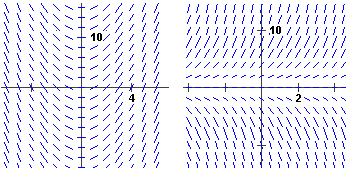
dy/dx = 5x dy/dx = y
Qui trovi come tracciare (con R) i campi direzionali delle eq. differenziali del 1º ordine.
Equazioni differenziali del primo ordine
Consider the first-order ODE
| y ′ = f (t, y) – ossia:
y '(t) = f (t, y(t)) |
|
describing the evolution of y as a function of t. If we know
initial conditions y(t0) = y0, two questions immediately come to
mind:
- Does y ′ = f(t,y), y(t0) = y0 have a solution?
- If so, can we find a formula for the solution?
The first question (nota anche come problema di Cauchy) is easily addressed:
Existence and Uniqueness Theorem
Suppose that f(t,y) and (∂f(t,y))/( ∂y) are
continuous on a closed rectangle R of the ty-plane. If
(t0,y0) ∈ R, then the IVP
has a unique solution y(t) on some t-interval containing t0.
In quali dei seguenti casi vi sono (x0,y0) per i quali non passa un'unica curva soluzione di y'=f(x,y)? [x e y variano tra -4 e 4]
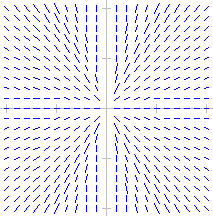
y'x = y (y' = y/x) |
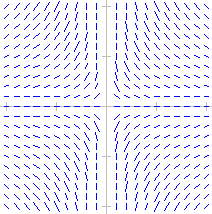
y'x = -y (y' = -y/x) |
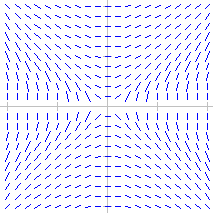
y'y = x (y' = x/y) |
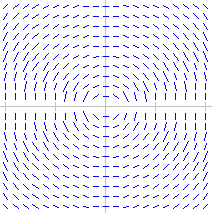
y'y = -x (y' = -x/y) |
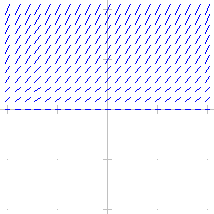
y' = √y |
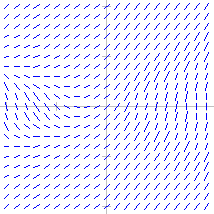
y' = 1+x/(y2+1) |
The second question is much more difficult, and often we need to
resort to numerical methods. However, in this tutorial we review four
of the most commonly-used analytic solution methods for first-order
ODES.
Separating the Variables
Esempio introduttivo:
y' = y, ossia dy/dt = y. Posso mettere da una parte le y e dall'altra le t.
Scrivo: dy /y = dt. Ma così perdo la soluzione y = 0: me lo annoto.
"Integro" i due membri: ∫ dy/y = ∫ dt.
Ottengo: log(y) = t + C1, log(-y) = t + C2
Applico exp: y = exp(t+C), y = -exp(t+C)
Queste soluzioni volendo posso riscriverle così:
y = exp(C)exp(t), y = -exp(C)exp(t), ovvero: y = C·exp(t), y = -C·exp(t), con C>0,
ovvero, unificandole: y = C·exp(t) con C numero reale qualunque; per C=0 recupero la soluzione che avevo perso "portando"
y dalla parte di y'.
La soluzioni trovate sono in accordo con quanto visto nel paragrafo introduttivo.
Trattazione generale:
If an ODE can be written in the form
then the ODE is said to be separable. In this case, a simple
solution technique can be derived as follows:
Suppose y = f(t) solves the ODE. Rewriting the ODE as
h(y)y ′ = g(t),
| | | |
| | since y = f(t), y ′ = f ′(t) |
| |
|
| | | |
| | Integrating with respect to t on each side. |
| |
|
| | | |
Upon integrating, we have our implicitly-defined general
solution of the ODE, which we can often solve explicitly for y(t).
Example
Let's solve the separable ODE y ′ = 4y/t. Separating the
variables and integrating,
|
| |
|
|
|
|
|
|
|
|
| Recall that
r ln a = ln ar and
ln a - ln b = ln a/b |
|
|
|
|
|
|
|
|
|
| eln a = a.
Relabel eC1as C2. |
|
|
|
|
|
|
|
|
| |
|
The general solution, y = ct4, defines a family of solution curves
corresponding to various initial conditions.
View Solutions
Using an Integrating Factor to solve a Linear ODE
If a first-order ODE can be written in the normal linear form
the ODE can be solved using an integrating factor μ(t) = e∫p(t)dt:
|
μ(t)[ y ′+ p(t)y ] = μ(t)q(t) |
|
|
| Multiplying both sides of the ODE by
μ(t). |
|
|
|
|
( μ(t)y ) ′ = μ(t)y ′+ μ ′(t)y and μ ′(t) = p(t) μ(t) using the chain rule to
differentiate μ(t) = e∫p(t)dt.
|
|
|
μ(t)y = |
∫ |
μ(t)q(t) dt + C |
|
|
|
Integrating each side with respect to t.
|
|
Dividing through by μ(t), we have the general solution of the
linear ODE.
Example
We can solve the linear ODE y ′-2ty = t using an integrating factor.
Here, p(t) = -2t and q(t) = 1, so
Multiplying both sides of the ODE by μ(t),
|
| |
|
|
| You can verify that
(e-t2y) ′ = e-t2(y ′-2ty)
by using the Chain Rule
to differentiate e-t2y |
|
|
|
|
|
|
| Integrating each side
with respect to t. |
|
|
|
| | Dividing through by e-t2. |
|
| |
|
You can verify that (e-t2y) ′ = e-t2(y ′-2ty)
by using the Chain Rule to differentiate e-t2y
Integrating each side with respect to t.
Dividing through by e-t2.
So the general solution of y ′-2ty = t is y(t) = Cet2-1/2.
For practice, solve y ′ = [4y/ t] by putting it in normal linear
form and using an integrating factor. Verify that you get the same
result as we did by separating the variables.
View Solutions
Using a Change of Variables
Often, a first-order ODE that is neither separable nor linear can be
simplified to one of these types by making a change of variables.
Here are some important examples:
- Homogenous Equation of Order 0: [dy/ dx] = f(x,y)
where f(kx,ky) = f(x,y).
Use the change of variables z = y/x to convert the ODE to
x[dz/ dx] = f(1,z)-z, which is separable.
- Bernoulli Equation: [dy/ dt]+p(t)y = q(t)yb (b ≠ 0,1).
Use the change of variables z = y1-b to convert the ODE to
[dx/ dt] + (1-b)p(t)z = (1-b)q(t), which is linear.
- Riccati Equation: [dy/ dt] = a(t)y+b(t)y2+ F(t).
If one particular solution g(t) is known, use the change of
variables z = [1/( y-g)] to convert the ODE to [dz/ dt]+(a+2bg)z = -b, which is linear.
When using a change of variables, solve the transformed ODE and then
return to the original variables to obtain the general solution of the
original ODE. Often, you will have to leave your solution in implicit
form.
Example
Let's solve the ODE dy/dx = [(y-x)/( x-4y)]. To see that it
is homogeneous of order 0, note that
|
f(kx,ky) = |
ky-kx
kx-4ky
|
= |
y-x
x-4y
|
= f(x,y) |
|
Let z = y/x. Then y = xz, so
dy/dx = x[dz/dx]+z. The ODE becomes
which is separable. Separating the variables and integrating,
|
| |
|
|
|
|
|
∫ |
|





 |
|
-3/2
2z+1
|
+ |
-1/2
2z-1
|





 |
dz |
|
|
| |
|
- |
3
4
|
ln|2z+1| - |
1
4
|
ln|2z-1| |
|
|
|
|
|
| Multiplying through
by -4 and relabelling
-4C1 as C2. |
|
|
|
|
|
|
|
|
|
|
|
|
| Returning to the
original variables
using z = y/x |
|
|
|
|
| |
|
The general solution, (2y+x)3(2y-x) = C, is written implicitly.
View Solutions
Finding an Integral for an Exact Equation
An ODE N(x,y)y ′+ M(x,y) = 0 is an exact equation if
(∂N)/(∂x) = (∂M)/(∂y) in a
region of the xy-plane. If we can find a function H(x,y) for
which (∂H)/(∂x) = M and (∂H)/(∂y) = N, then H(x,y) is called an integral of the
ODE and H(x,y) = C is the general solution of the original ODE.
To find H(x,y), note that
|
H(x,y) = |
∫ |
M(x,y)dx + g(y) |
|
for some g(y) since [(∂H)/( ∂x)] = M(x,y). To
find g(y), calculate
|
|
∂H
∂y
|
= |
∂
∂y
|
|




 |
|
∫ |
M(x,y)dx |




 |
+ g ′(y) |
|
and set it equal to N(x,y). Solve for g ′(y) (which will be
independent of x) and integrate with respect to y to obtain
g(y), and so H(x,y), explicitly. Notice that our solution H(x,y) = C is written in implicit form. (Alternatively, we can start with
H(x,y) = ∫N(x,y)dy + h(x) for some h(x) and proceed
accordingly.)
Example
The ODE ( 2yx2 + 4 ) [dy/ dx] + ( 2y2x -3) = 0 is exact, since for N(x,y) = 2yx2 + 4 and M(x,y) = 2y2x -3,
Thus, there exists an integral H(x,y) for which
|
|
∂H
∂x
|
= 2y2x-3 and |
∂H
∂y
|
= 2yx2+4. |
|
From the first of these,
Then (∂H)/(∂y) = 2yx2 + g ′(y) = 2yx2+4, so
g ′(y) = 4.
Integrating, g(y) = 4y, so H(x,y) = y2x2-3x+4y.
The general solution is given implicitly by
View Solutions
Key Concepts [index]
| • Separable ODES: dy/dt = g(t)/ h(y) |
The general solution is given by integrating ∫h(y)dy = ∫g(t)dt +C |
• Linear First-Order ODEs: y ′+ p(t)y = g(t)
Use an integrating factor e∫p(t)dt
• Homogeneous of Order Zero,
Benoulli Equation,
Riccati Equation: | | Use the appropriate change of
variable to convert the original ODE into either a separable ODE or a
linear ODE. |
| • Exact ODEs: | | N(x,y)y ′+ M(x,y) = 0,
where (∂N)/(∂x) = (∂M)/(∂y) | | Find H(x,y) such that (∂H)/(∂x) = M and (∂H)/(∂y) = N. The
general solution is given by H(x,y) = C. |
|











